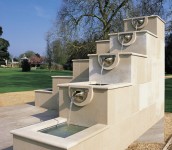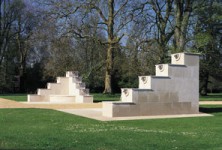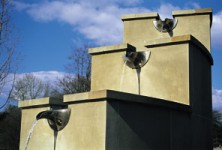
Scala Aquæ Pembrochiana
The responsibility of placing contemporary sculpture within an historic setting is fully recognised by William Pye, and siting Scala Aquæ Pembrochiana in full view of the façade of Wilton House, designed by Inigo Jones c 1650 with additional work by James Wyatt in 1810, was a great test for the contemporary artist. Pye had been introduced to The Earl of Pembroke by Sir Richard Carew Pole, for whom he made Antony Cone in 1996, and met the challenge at Wilton with slight epidation, which he quickly overcame.
Pye wanted to create a sculpture that would not interrupt the view of Wilton House, but equally he wanted the piece to be fully visible from it. His solution was a simple, stepped, stone structure that related to the house through his use of Portland stone and through its formal symmetry. In setting the sculpture at the intersection of two wide paths, it marks the junction and is symbolic of a gatehouse. Two sets of four wide steps stand facing the house and at right angles to it. Each set has four bronze spouts that pour water into four receiving, rectangular pools. Both sets of steps also face each other in symmetrical alignment across the pathway leading to the house. The sculpture is some hundred metres from the house affording uninterrupted views of the eastern frontage. However, when viewed some fifty metres further away from the house, it appears to frame the façade.




